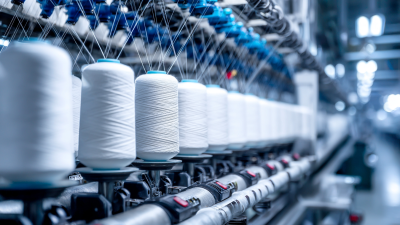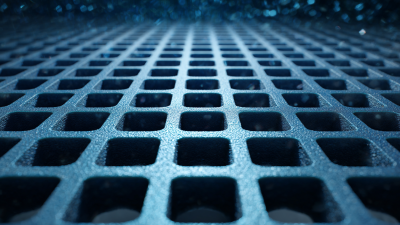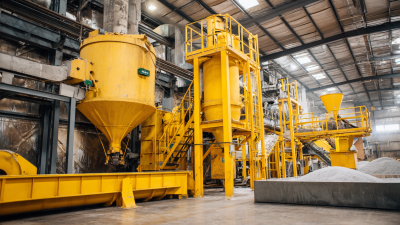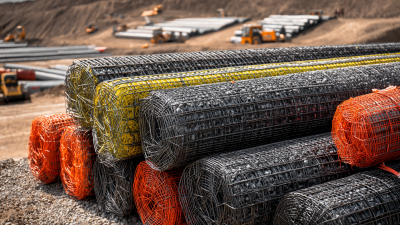How to Effectively Use Fiberglass Stitched Fabric in Your Projects
Table of Contents
- Understanding the Properties of Fiberglass Stitched Fabrics
- Choosing the Right Type of Fiberglass Fabric for Your Project
- Preparation Steps Before Working with Fiberglass Stitched Fabric
- Techniques for Cutting and Shaping Fiberglass Fabrics
- Best Practices for Bonding and Finishing with Fiberglass
- Common Mistakes to Avoid When Using Fiberglass Stitched Fabrics
- Exploring the YRS3-M-V Bi-Axial Warp Knitting Machine: Features, Applications, and Benefits in Non-Woven Fabric Production
- FAQS
- Conclusion
- Related Posts
The effective utilization of Fiberglass Stitched Fabric is an essential aspect in various industrial applications, particularly in sectors such as automotive, construction, and aerospace, where lightweight yet strong materials are crucial. According to industry research, the global fiberglass market is projected to reach $20 billion by 2026, highlighting the increasing demand for advanced composite materials. DANYANG YIXUN MACHINERY CO., LTD specializes in the production of multiaxial and biaxial warp knitting machines, along with stitch bonding warp knitting machines designed specifically for glass fiber applications. This evolving landscape necessitates an understanding of how to leverage Fiberglass Stitched Fabric for enhanced performance and durability. By exploring effective usage strategies in projects, companies can not only improve product quality but also optimize manufacturing processes, ensuring they meet the standards of modern engineering demands.

Understanding the Properties of Fiberglass Stitched Fabrics
 Fiberglass stitched fabrics are gaining attention in various industries due to their unique properties. These materials are composed of fiberglass strands that are interconnected, creating a sturdy yet flexible product. This structure enhances their strength while maintaining lightweight characteristics, making them ideal for applications in automotive, construction, and aerospace sectors. The versatility of fiberglass stitched fabrics allows them to be used for everything from boat hulls to insulation materials, capitalizing on their durability and resistance to environmental factors.
Fiberglass stitched fabrics are gaining attention in various industries due to their unique properties. These materials are composed of fiberglass strands that are interconnected, creating a sturdy yet flexible product. This structure enhances their strength while maintaining lightweight characteristics, making them ideal for applications in automotive, construction, and aerospace sectors. The versatility of fiberglass stitched fabrics allows them to be used for everything from boat hulls to insulation materials, capitalizing on their durability and resistance to environmental factors.
Artist Viraj Khanna’s recent exhibition, "Brain Rot: The Life You Live?", showcases a creative use of fiberglass in the art world. By incorporating fiberglass sculptures and embroidered textiles, Khanna explores deep themes of cultural identity and mental health. His work not only highlights the material's physical properties but also its capability to convey complex narratives. As industries continue to recognize the benefits of fiberglass stitched fabrics, the artistic realm is similarly embracing these innovative materials to express profound cultural concepts. The projected growth of the fiberglass fabric market further underscores its increasing importance across multiple fields.
Choosing the Right Type of Fiberglass Fabric for Your Project
When embarking on a project that involves fiberglass stitched fabric, selecting the right type is crucial to ensure optimal performance and durability. Fiberglass fabrics come in various weaves, weights, and finishes, each tailored for specific applications. Common types include plain weave, satin weave, and twill weave, with plain weave being the most versatile and suitable for general use, while satin weave offers a smoother finish ideal for aesthetic applications.
Additionally, considering the weight of the fiberglass fabric is essential. Lighter fabrics are easier to work with and ideal for projects requiring flexibility, such as repairs or custom shapes. Heavier fabrics provide greater strength and are suitable for structural applications, such as boat building or reinforcement in high-stress environments. Beyond weave and weight, also assess the resin compatibility and environmental factors, as some fabrics may perform better under UV exposure or extreme temperatures. By carefully evaluating these elements, you can select the perfect fiberglass stitched fabric that meets the specific needs of your project.
Preparation Steps Before Working with Fiberglass Stitched Fabric
Before diving into projects involving fiberglass stitched fabric, adequate preparation is crucial for achieving optimal results. DANYANG YIXUN MACHINERY CO., LTD, a leading manufacturer of specialized knitting machines, emphasizes the importance of understanding the materials and tools utilized in these processes. According to a report by MRG (Market Research Group), the demand for fiberglass textiles has seen a steady increase, with the market projected to grow at a CAGR of 5.2% from 2022 to 2028. This trend underscores the value of high-quality equipment such as multiaxial and biaxial warp knitting machines in producing durable, reliable materials.
One effective preparation step is to ensure that the workspace is clean and well-organized. Dust and contaminants can compromise the integrity of the fiberglass, leading to subpar outcomes. Additionally, it is recommended to familiarize oneself with the properties of the specific fiberglass stitched fabric to be used. Different weights and weave patterns may require varied handling techniques. As noted in the International Journal of Adhesion and Adhesives, proper handling can reduce waste and improve bonding efficiency, which is essential for producing robust composites in line with industry standards. By taking these preparation steps, one can enhance the success rates of their fiberglass projects significantly.
Usage of Fiberglass Stitched Fabric in Various Projects
Techniques for Cutting and Shaping Fiberglass Fabrics
When working with fiberglass stitched fabric, cutting and shaping techniques play a crucial role in achieving the desired results for your projects. One effective method for cutting fiberglass is to use sharp scissors specifically designed for composite materials. These scissors help ensure clean edges and minimize fraying, making the fabric easier to work with. It's essential to wear protective gear, such as gloves and a mask, to guard against the fine particles produced during the cutting process.
Shaping fiberglass fabrics can be completed in various ways, depending on the project's specific needs. One technique involves using a heat gun to gently warm the fabric, allowing it to become more pliable. This makes it easier to mold around curves and edges. For more intricate shapes, consider using a mold or frame to support the fabric as it cures. Additionally, layering the stitched fabric can provide added strength and durability. When combining pieces, apply a resin to bond the layers effectively, ensuring a robust final product. These methods not only enhance precision in your work but also optimize the performance of the fiberglass in the intended application.
Best Practices for Bonding and Finishing with Fiberglass
When working with fiberglass stitched fabric, achieving a secure and durable bond is paramount. Best practices for bonding start with surface preparation; surfaces should be clean and free from contaminants. According to a report by the Composites Manufacturing Association, proper surface preparation can enhance adhesion by up to 50%. Using the correct type of resin—whether epoxy, polyester, or vinyl ester—can also significantly impact the bond's strength. Always consult the manufacturer's specifications to ensure compatibility.
Tips for bonding with fiberglass include using a roller to eliminate air bubbles after applying resin, which can weaken the bond. Additionally, consider the environment where the work is being done; temperature and humidity can affect curing times and the quality of the bond. A report from the American Composites Manufacturers Association reveals that maintaining optimal working conditions can reduce curing issues, leading to increased project reliability.
Finishing is equally essential in fiberglass projects. For a smooth finish, sanding is necessary after the initial cure. Utilizing finer grits progressively leads to an optimal surface for painting or gel-coating. It's recommended to seal the surface with a primer specifically designed for fiberglass, which enhances both appearance and durability. Following these best practices will not only improve bond strength but also enhance the overall aesthetics of your project.
Common Mistakes to Avoid When Using Fiberglass Stitched Fabrics
When working with fiberglass stitched fabrics, avoiding common mistakes can significantly impact the quality and durability of your projects. One of the most frequent errors is underestimating the importance of proper surface preparation. According to the Composite Materials Handbook, a well-prepared surface can enhance adhesion by up to 50%, which is crucial for the integrity of composite laminates. Failing to clean or sand the surface adequately can lead to poor bonding, resulting in delamination and compromised structural strength.
Another critical mistake is using the wrong resin or insufficient resin application. Research by the American Composites Manufacturers Association reveals that improper resin choice can negatively affect tensile strength and flexibility, potentially leading to catastrophic failures in applications such as automotive and aerospace components. To avoid this, it’s essential to follow manufacturer guidelines closely and ensure that the fabric is thoroughly saturated with the appropriate resin, which is generally recommended to be around 50-60% by weight. By addressing these common pitfalls, project outcomes can be vastly improved, making the most of fiberglass stitched fabrics' unique properties.

Exploring the YRS3-M-V Bi-Axial Warp Knitting Machine: Features, Applications, and Benefits in Non-Woven Fabric Production
The YRS3-M-V Bi-Axial Warp Knitting Machine is a revolutionary tool designed for the production of non-woven fabrics, particularly in the creation of reinforcement geo composites. This machine utilizes a one-time forming process, which enhances efficiency and reduces production times. With various gauge options including E3, E6, and E9, as well as a flexible width measurement ranging from 186” to 225”, the YRS3-M-V is adaptable to diverse manufacturing requirements.
The versatility of this machine is further highlighted by its speed capabilities, which range from 50 to 1200 revolutions per minute, tailoring the output according to specific product demands. This makes the YRS3-M-V ideal for industries that require high-quality, reinforced fabric materials, as it can meet varying needs without compromising on speed or quality. Its innovative design and functionality make it a valuable asset in the realm of non-woven fabric production, paving the way for advancements in material engineering and composite manufacturing.
FAQS
: Fiberglass stitched fabrics are composed of interconnected fiberglass strands that create a sturdy yet flexible material.
These fabrics are ideal for applications in industries such as automotive, construction, aerospace, and even artistic installations.
It is recommended to use sharp scissors designed for composite materials to ensure clean edges and minimize fraying.
When cutting fiberglass, it is essential to wear gloves and a mask to protect against fine particles produced during the process.
Shaping can be achieved by warming the fabric with a heat gun for pliability, or by using a mold or frame for more intricate shapes.
Proper surface preparation is critical, as clean surfaces free of contaminants enhance adhesion significantly.
The choice of resin—epoxy, polyester, or vinyl ester—should be based on the project requirements and compatibility with the materials used.
Using a roller to apply resin helps eliminate air bubbles, which can weaken the bond.
Sanding after initial curing, using finer grits progressively, and sealing the surface with a fiberglass primer are essential for achieving a smooth finish.
Temperature and humidity can impact curing times and bond quality, so maintaining optimal working conditions is crucial for project reliability.
Conclusion
Fiberglass Stitched Fabric is a versatile material that offers strength and durability for various projects. Understanding its properties is essential to selecting the right type of fiberglass fabric for specific applications, ensuring optimal performance. Before working with fiberglass, proper preparation steps are crucial. Techniques for cutting and shaping this fabric require skill to avoid damage and achieve desired results. Additionally, best practices for bonding and finishing can significantly enhance the longevity and effectiveness of the final product.
However, users must be aware of common mistakes to avoid when working with Fiberglass Stitched Fabric to ensure successful outcomes. At DANYANG YIXUN MACHINERY CO., LTD, we specialize in manufacturing machinery tailored for producing high-quality fiberglass textiles, including multiaxial and stitch bonding warp knitting machines, to meet the needs of various industries.
Related Posts
-

How to Maximize Efficiency with Weft-Insertion Warp Knitting Machines in Textile Production
-

Challenges Encountered with Glass Fiber Grille in Global Market
-

How to Leverage Fiberglass Stitched Fabric for Superior Composite Strength and Performance?
-

How to Optimize Your Production Line Efficiency with a Multifunction Batching Device
-

The Ultimate Guide to Understanding Geogrid Material for Construction Success
-

15 Best Polyester Geogrid Insights for Global Buyers


